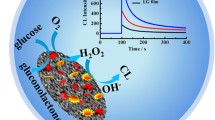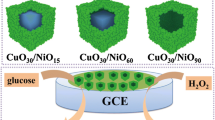Abstract
The concept of enzyme-assisted substrate sensing based on use of fluorescent markers to detect the products of enzymatic reaction has been investigated by fabrication of micron-scale polyelectrolyte capsules containing enzymes and dyes in one entity. Microcapsules approximately 5 μm in size entrap glucose oxidase or lactate oxidase, with peroxidase, together with the corresponding markers Tris(4,7-diphenyl-1,10-phenanthroline)ruthenium(II) dichloride (Ru(dpp)) complex and dihydrorhodamine 123 (DHR123), which are sensitive to oxygen and hydrogen peroxide, respectively. These capsules are produced by co-precipitation of calcium carbonate particles with the enzyme followed by layer-by-layer assembly of polyelectrolytes over the surface of the particles and incorporation of the dye in the capsule interior or in the multilayer shell. After dissolution of the calcium carbonate the enzymes and dyes remain in the multilayer capsules. In this study we produced enzyme-containing microcapsules sensitive to glucose and lactate. Calibration curves based on fluorescence intensity of Ru(dpp) and DHR123 were linearly dependent on substrate concentration, enabling reliable sensing in the millimolar range. The main advantages of using these capsules with optical recording is the possibility of building single capsule-based sensors. The response from individual capsules was observed by confocal microscopy as increasing fluorescence intensity of the capsule on addition of lactate at millimolar concentrations. Because internalization of the micron-sized multi-component capsules was feasible, they could be further optimized for in-situ intracellular sensing and metabolite monitoring on the basis of fluorescence reporting.












Similar content being viewed by others
References
Goldys EM (2009) Fluorescence applications in biotechnology and life sciences. Wiley–Blackwell, London
Mason WT (1999) Fluorescent and luminescent probes for biological activity, 2nd edn. Academic Press
Kobayashi H, Ogawa M, Alford R, Choyke PL, Urano Y (2010) New strategies for fluorescent probe design in medical diagnostic imaging. Chem Rev 110:2620–2640
Gomez-Hens A, Valarcel M (1982) Spectrofluorimetric determination of inorganic anions: a review. Analyst 107:465–465
Donoso P, Mill JG, O’Neill SC, Eisner DA (1992) Fluorescence measurements of cytoplasmic and mitochondrial sodium concentration in rat ventricular myocytes. J Physiol 448:493–509
Takahashi A, Camacho P, Lechleiter JD, Herman B (1999) Measurement of intracellular calcium. Physiol Rev 79:1089–1125
Pickupa JC, Hussaina F, Evansa ND, Rolinskib OJ, Birch DJS (2005) Fluorescence-based glucose sensors. Biosens Bioelectron 20:2555–2565
Brown JQ, Srivastava R, Zhu H, McShane MJ (2006) Enzymatic fluorescent microsphere glucose sensors: evaluation of response under dynamic conditions. Diabetes Technol Ther 8:288–295
Clark HA, Hoyer M, Philbert MA, Kopelman R (1999) Optical nanosensors for chemical analysis inside single living cells. Fabrication, characterization, and methods for intracellular delivery of PEBBLE sensors. Anal Chem 71:4831–4836
Xu H, Aylott JW, Kopelman R (2002) Fluorescent nano-PEBBLE sensors designed for intracellular glucose imaging. Analyst 127:1471–1477
del Mercato LL, Rivera-Gil P, Abbasi AZ, Ochs M, Ganas C, Zins I, Sönnichsen C, Parak WJ (2010) Multilayer capsules: recent progress and future outlook for their use in life sciences. Nanoscale 2:458–467
Rivera-Gil P, Nazarenus M, Ashraf S, Parak WJ (2012) pH sensitive capsules as intracellular optical reporters for monitoring lysosomal pH changes upon stimulation. Small 8:943–948
Lee YEK, Smith R, Kopelman R (2009) Nanoparticle PEBBLE sensors in live cells and in vivo. Annu Rev Anal Chem 2:57–76
del Mercato LL, Abbasi AZ, Ochs M, Parak WJ (2011) Multiplexed sensing of ions with barcoded polyelectrolyte capsules. ACS Nano 5:9668–9674
del Mercato LL, Abbasi AZ, Parak WJ (2011) Synthesis and characterization of ratiometric ion-sensitive polyelectrolyte capsules. Small 7:351–363
Kazakova LI, Shabarchina LI, Sukhorukov GB (2011) Co-encapsulation of enzyme and sensitive dye as a tool for fabrication of microcapsule based sensor for urea measuring. Phys Chem Chem Phys 13:11110–11117
Sukhorukov GB, Donath E, Lichtenfeld H, Knippel E, Knippel M, Budde A, Möhwald H (1998) Layer-by-layer self-assembly of polyelectrolytes on colloidal particles. Colloids Surf A 137:253–266
Sukhorukov GB, Donath E, Davis S, Lichtenfeld H, Caruso F, Popov VI, Möhwald H (1998) Stepwise polyelectrolyte assembly on particle surfaces: a novel approach to colloid design. Polym Adv Technol 9:759–767
Kreft O, Muñoz Javier A, Sukhorukov GB, Parak WJ (2007) Polymer microcapsules as mobile local pH-sensors. J Mater Chem 17:4471–4476
Brasuel M, Kopelman R, Miller TJ, Tjalkens R, Philbert MA (2001) Fluorescent nanosensors for intracellular chemical analysis: decyl methacrylate liquid polymer matrix and ion-exchange-based potassium PEBBLE sensors with real-time application to viable rat C6 glioma cells. Anal Chem 73:2221–2228
Cao Y, Lee Koo YE, Kopelman R (2004) Poly(decyl methacrylate)-based fluorescent PEBBLE swarm nanosensors for measuring dissolved oxygen in biosamples. Analyst 129:745–750
Petrov AI, Volodkin DV, Sukhorukov GB (2005) Protein–calcium carbonate coprecipitation: a tool for protein encapsulation. Biotechnol Prog 21:918–925
Volodkin DV, Petrov AI, Prevot M, Sukhorukov GB (2004) Matrix polyelectrolyte microcapsules – new and high effective system for macromolecule encapsulation. Langmuir 20:3398–3406
Bradford MM (1976) A rapid and sensitive method for the quantitation of microgram quantities of protein utilizing the principle of protein–dye binding. Anal Biochem 72:248–254
Raba J, Mottola HA (1995) Glucose oxidase as an analytical reagent. Crit Rev Anal Chem 25:1–42
Fuller ZJ, Bare WD, Kneas KA, Xu W, Demas JN, DeGraff BA (2003) Photostability of luminescent ruthenium(ii) complexes in polymers and in solution. Anal Chem 75:2670–2677
Carraway ER, Demas JN, DeGraff BA, Bacon JR (1991) Photophysics and photochemistry of oxygen sensors based on luminescent transition-metal complexes. Anal Chem 63:337–342
Choi MMF, Xiao D (1999) Linear calibration function of luminescence quenching-based optical sensor for trace oxygen analysis. Analyst 5:695–698
Bacon R, Demas J (1987) Determination of oxygen concentrations by luminescence quenching of a polymer immobilized transition metal complex. Anal Chem 59:2780–2785
Demas JN, DeGraff BA, Xu W (1995) Modeling of luminescence quenching-based sensors: comparison of multisite and nonlinear gas solubility models. Anal Chem 67:1377–1380
Draxler S, Lippitsch ME, Klimant I, Kraus H, Wolfbeis OS (1995) Effects of polymer matrices on the time-resolved luminescence of a ruthenium complex quenched by oxygen. J Phys Chem 99:3162–3167
Kabanov VA (2005) Polyelectrolyte complexes in solution and in bulk. Russ Chem Rev 74:3–20
McShane MJ, Brown JQ, Guice KB, Lvov YM (2002) Polyelectrolyte microshells as carriers for fluorescent sensors: loading and sensing properties of a ruthenium-based oxygen indicator. J Nanosci Nanotechnol 2:1–6
Chang-Yen DA, Lvov Y, McShane MJ, Gale BK (2002) Electrostatic self-assembly of a ruthenium-based oxygen sensitive dye using polyion–dye interpolyelectrolyte formation. Sensors Actuators B 87:336–345
Volodkin DV, Larionova NI, Sukhorukov GB (2004) Protein encapsulation via porous CaCO3 microparticles templating. Biomacromolecules 5:1962–1972
Zor T, Selinger Z (1996) Linearization of the Bradford protein assay increases its sensitivity: theoretical and experimental studies. Anal Biochem 236:302–308
Henderson LM, Chappell JB (1993) Dihydrorhodamine 123: a fluorescent probe for superoxide generation? Eur J Biochem 217:973–980
Delcea M, Yashchenok A, Videnova K, Kreft O, Mohwald H, Skirtach AG (2010) Multicompartmental micro- and nanocapsules: hierarchy and applications in biosciences. Macromol Biosci 10:465–474
De Koker S, De Geest BG, Cuvelier C, Ferdinande L, Deckers W, Hennink WE, De Smedt SC, Mertens N (2007) In vivo cellular uptake, degradation, and biocompatibility of polyelectrolyte microcapsules. Adv Funct Mater 17:3754–3763
Pavlov AM, Sapelkin AV, Huang X, P’ng KMY, Bushby AJ, Sukhorukov GB, Skirtach AG (2011) Neuron cells uptake of polymeric microcapsules and subsequent intracellular release. Macromol Biosci 11:848–854
Acknowledgements
L.K. is grateful for a DAAD stipend. The authors are grateful to Professor Helmuth Möhwald for continuous support and stimulating discussion. This project was funded by Ministry of Education and Science of the Russian Federation, contracts 02.740.11.5226 and 14.740.11.1363.
Author information
Authors and Affiliations
Corresponding author
Additional information
Published in the topical collection Characterization of Thin Films and Membranes with guest editors Daniel Mandler and Pankaj Vadgama.
Rights and permissions
About this article
Cite this article
Kazakova, L.I., Shabarchina, L.I., Anastasova, S. et al. Chemosensors and biosensors based on polyelectrolyte microcapsules containing fluorescent dyes and enzymes. Anal Bioanal Chem 405, 1559–1568 (2013). https://doi.org/10.1007/s00216-012-6381-0
Received:
Revised:
Accepted:
Published:
Issue Date:
DOI: https://doi.org/10.1007/s00216-012-6381-0




